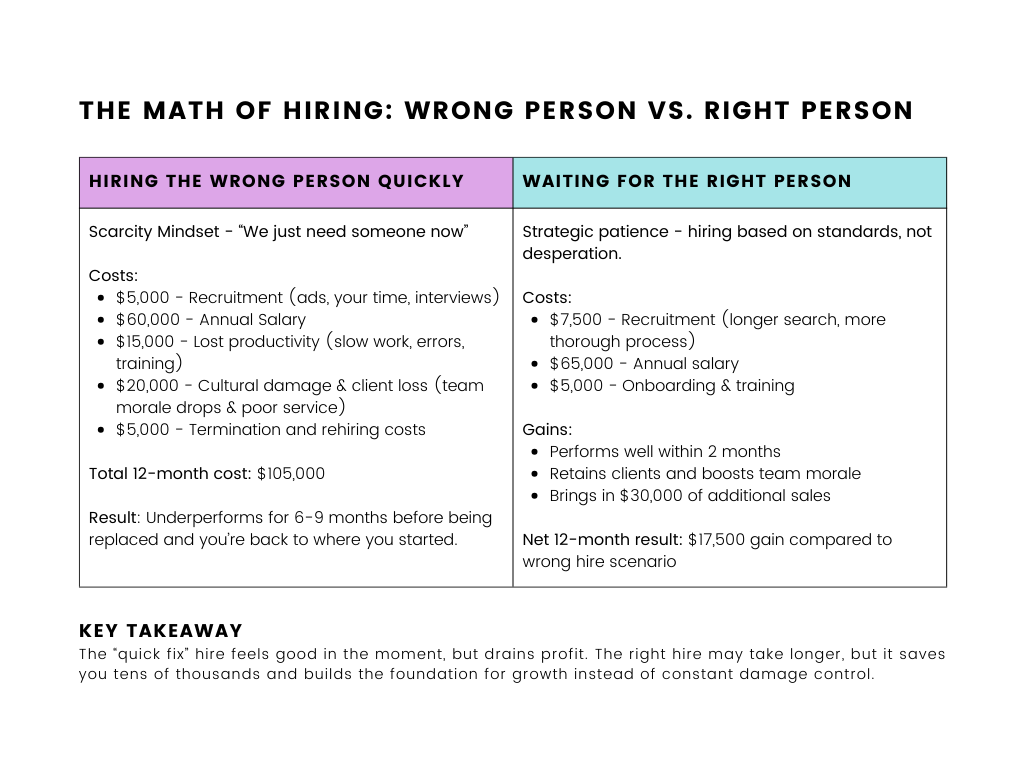Hire the Best, Fire the Rest: Standards, Not Desperation
Hiring in a small business can feel like trying to find a decent avocado at the supermarket. You’re sifting through a pile, most are either too hard or already rotten, and the perfect one always seems to have been taken by someone else five minutes earlier.
When the pressure is on, whether it be busy season or an unexpected resignation, you become tempted to lower your standard just to get a body through the door.
Your brain shifts into what psychologists call a scarcity mindset. This is where your focus narrows to the immediate problem. In this case, “I need someone in this seat now”, at the expense of long-term thinking. It’s a survival response: our brains are wired to prioritise short-term relief over long-term gain when we’re under pressure. The problem is, in business, this can lead to costly mistakes. Hiring out of desperation may solve today’s problem, but it often creates bigger ones later - poor performance, cultural clashes, and the need to rehire all over again. Recognising this bias is key to slowing down, shifting back to smarter, more strategic thinking, and making a choice that’s right for your business in the long run.
Why “Good Enough” Isn’t Good Enough
Every hire in a small business has a big footprint. In a large company, a poor performer can hide in a small team; they’re instantly visible, and their mistakes are instantly felt.
A friend of mine ran a busy café. She lost a barista right before the Christmas rush. In a panic, she hired the first applicant who could spell “latte”. By day two, she had customers complaining about orders taking forever, and by the second week, she was giving out free drinks because they were wrong. She thought she was saving the business by hiring quickly, but in reality, sales dropped, morale tanked, and she spent more time fixing problems than if she’d just rolled up her sleeves and worked short-staffed for a few weeks and taken the time to hire well.
The Other Side of the Coin
Contrast that with a small landscaping business. Let’s say that they lost a crew member in peak season but refused to hire just ‘anyone’. Instead, he and his team worked longer days for three weeks while he kept looking. He also compensated his existing employees for the hassle. He eventually finds a new employee with great skills, a good work ethic and a personality that fits right in with the existing crew.
Within two months, he’d boosted the productivity of the team, taking on bigger projects and earning more than before. I hate this saying, but I guess it fits – short term pain for long-term gain.
A Bad Hire Costs More Than You Think
When I talk about the cost of a bad hire, I’m not just talking about their wage. I’m talking about the time you spend fixing mistakes, the opportunities you miss because you’re managing issues and the morale cost when employees leave because they’re tired of carrying dead weight.
A Harvard Business Review study found that the impact of a single toxic employee can outweigh the benefits of several top performers. In a small business, that effect is magnified.
Firing Doesn’t Mean You’re Heartless
Firing ‘the rest’ doesn’t mean being cold-blooded. It means you recognise that keeping the wrong person in the wrong role is unfair – to them, to you and to the rest of the team.
I once had a conversation with a tradie who kept a long-term employee on because they had been with the business since the start, and the “customers know them”. The problem was that they’d stopped learning, stopped improving and had developed a bit of a habit of talking down to newer staff.
After a particularly bad incident with a customer, the owner made a decision to let them go. Within a month, the team atmosphere was better, and sales picked up.
Loyalty is important, but loyalty without performance is just nostalgia.
Putting a Good Hiring Process in Place
If you want to hire the best, you need a process that makes it harder to hire the wrong person than it is to hire the right one. That might mean using practical tests in interviews (if you’re hiring a barista, get them to make a coffee), asking behavioural questions that show problem-solving skills and involving team members to check for culture fit.
If you’re unsure, don’t hire yet.
Your Business, Your Standards
Every hire is an investment, so make sure it’s one that pays off. By protecting your standards, you protect your culture, your customer experience and your ability to grow. The right person will multiply your efforts, while the wrong person will drain them.

